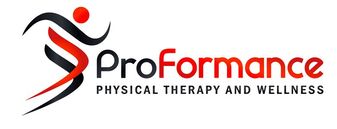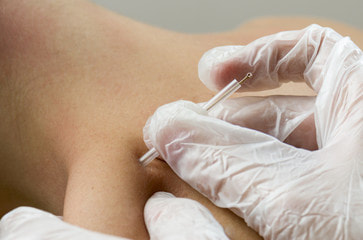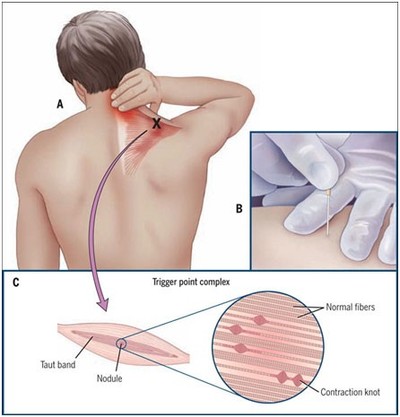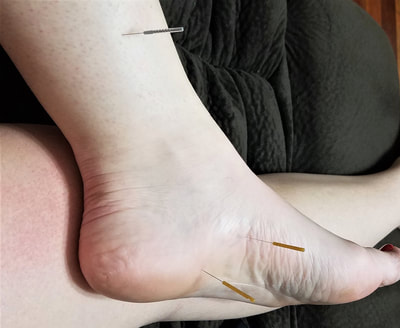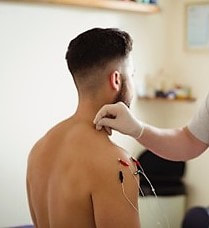|
Can dry needling help me?
If you have chronic tightness or acute spasms from a recent injury, dry needling may be able to relax those muscles and help you move normally again. Patients have seen relief in chronic back pain limiting sleeping and bending, hamstring immobility limiting exercise, shoulder pain limiting reaching, tingling down the arms from cervical tightness, and post-surgical Achilles tightness limiting walking to mention just a few people’s stories who have been helped by Dr. Duggan’s dry needling. APTA article, reports that “Clinical research suggests that dry needling helps reduce local and peripheral pain and sensitization, thereby hastening the restoration of muscle function and range of motion.” Have you had a muscle that seems to have shut off? Patients have received benefit from functional dry needling through improved muscle activation. For example, patients have experienced cessation of back pain post-partum that was caused by deep back stabilizers shutting off from the stress of child birth. Dry needling to those muscles caused them to activate again, improved the body's awareness of those muscles, and improved the normal use of the muscles again. Dr. Duggan will assess you on evaluation and discuss with you if dry needling will be beneficial for you. What is dry needling? Trigger dry needling is a technique to treat musculoskeletal and myofascial pain and movement impairments. A small needle is inserted into tight areas of muscle or trigger points to decrease tightness, pain, and movement restriction. The needle is much smaller than the ones used to give shots, and no medications are delivered, hence the dry needling name. A muscle “twitch” may occur signaling improved fiber mobility of the restricted area. Your body then works to heal the area as helpful chemical mediators are released to provide mechanical, chemical, endocrinological, microvascular, neural, and central benefits. Chronic and acute pain suffers often notice immediate improvements in pain, range of motion, and movement ability. However, it may require several treatments for the full benefit. Dry needling can also be used for muscle activation and inhibition (reduction in tone, spasms, overuse) in addition to pain relief. Additional information on immediate benefits can be found at: (NCBI) What are trigger points? (picture 2) Trigger points are tender, uncomfortable areas in muscles and fascia that cause pain at rest or with movement. Travell and Simons have published extensive work on trigger points and how they refer pain to other areas of the body. Dry needling focuses on targeting these trigger points to relieve pain at the area of insertion or farther away along the referral pathway. What about intra-muscular electrical stimulation? (picture 4) ProFormance is happy to offer this service for your stubborn muscle spasms and trigger points. An electrical stimulation device is connected to the needles while they are in the targeted areas. Then, electrical stimulation is applied through the muscle as opposed to on top of the muscle like with a TENS unit. The stimulation is low and to your tolerance to assist in breaking pain-spasm cycles without pain. *Is dry needling the same as acupuncture? No. Traditional Chinese Medicine uses meridians to determine treatment. Dry needling targets areas of tightness or trigger points and focuses on changing tissue integrity and pain. It is based on anatomical and physiological concepts using scientific research to improve patient function and pain. See this article for more information: PT Renaissance article What shoulder I expect during a dry needling session? Dr. Duggan will examine you and determine if dry needling is an appropriate intervention for you. The dry needling will focus on specific areas found during your examination and therapy sessions that she feels will benefit your pain and movement restrictions. Dry needling cam be performed that day. You will need comfortable, loose clothing that allows the targeted areas to be accessed during the sessions. The needles are in sterilized and pre-packaged. Your skin will be cleaned with alcohol so please refrain from wearing copious amounts of lotion in the dry needling areas. Does dry needling hurt? As the needle is inserted, you may feel a prick. However, many patients do not feel it. A brief local twitch or muscle jump may occur as the needle is inserted. The is not uncommon. You may feel some aching, but this subsides as the muscle relaxes. Many patients feel very little during the treatment aside from the ache that quickly eases off. Some patients report soreness afterward that gradually eases off. This can be addressed with heat, ice, massage, or stretching if needed. Your communication during treatment will be beneficial in targeting the painful areas and adjusting the treatment to provide optimal results. After treatment, we will compare pre and post pain levels and movement ability. Often, immediate benefits are noticeable. Can anyone have dry needling? Dr. Duggan will discuss with you if you have any concerns or medical history that may restrict your ability to have dry needling. Please call 256-203-3804 to further discuss if dry needling will help you. Why wait to see if a few sessions can help get you back to the life you want?! Additional References 1. Cummings MT, White AR. Needling therapies in the management of myofascial trigger point pain: a systematic review. Arch Phys Med Rehabil. 2001;82(7):986–992. Free Article. 2. Kalichman L, Vulfsons S. Dry needling in the management musculoskeletal pain. J Am Board Fam Med. 2010;23(5):640–646. Free Article. |
Click above for details on any promotions being offered or special events to catch the team at.
Archives
July 2024
Categories |
Huntsville Location |
Athens
|
HoursMon-Thurs: 8am - 5pm
Friday: 8am-5pm |
Contact numbers |
|
